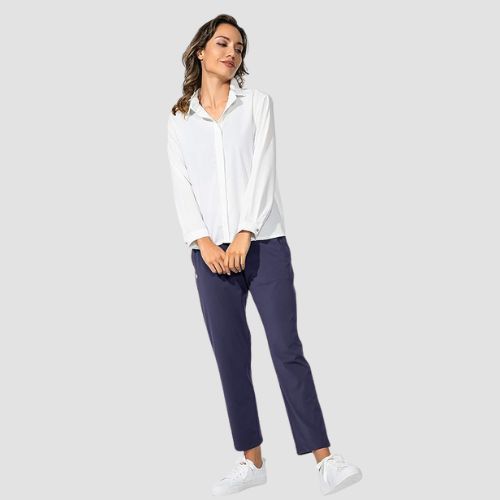How does dressing for success affect your confidence and career? I’ve learned that our outfits can dictate our mindset and other people’s perception of us.
I prioritize convenience over couture. So, my wardrobe leans toward comfortable and borderline acceptable: Pact Organic T-Shirt, The Gym People Joggers, and Veja Recife Sneakers. But I dress up a wee bit for a virtual meeting. A Club Monaco Linen Blazer over my everyday shirt, a dab of Ilia Hydrating Lip Balm, and suddenly I’m sitting a little straighter, speaking with more authority, and yes, somehow feeling smarter.
It’s not just in my head. Studies on enclothed cognition—how clothes influence our minds—suggest that your clothes can change how you feel, help you fit in, and shape how others see you.
In this article, we’ll explore how your outfit can give you an edge in all three.
Social Pressure and Professional Attire
When I think of dressing for success, I can’t help but picture an image of a neatly pressed suit, polished shoes, and maybe a tie. For years, that’s been the standard—at least in most professional settings. The history of dress codes in the workplace is, in many ways, a history of social control. It’s a quiet but powerful way to signal who’s in charge and who’s not. The classic suit and tie is a symbol of professionalism. But it’s also a way to reinforce a certain idea of authority—one that has been passed down for generations.
Many moons ago, the rules were simple: dress sharp, conform to the standards, and you’d make it through the day without offending anyone’s sensibilities. In the mid-20th century, wearing a business suit became a symbol of success. Power dressing was popular, but what did it really mean? It meant blending in—looking as professional as you were expected to act. You could be a revolutionary thinker, but you’d better do it in a tailored blazer.
Today, workplace dress codes have relaxed. The tech industry is into the casual vibe and the pandemic showed us that pants aren’t always necessary. Either way, offices are now much less traditional. You can see everyone wearing jeans and T-shirts.
It’s freeing—no more stiff collars or uncomfortable blazers. But it also presents challenges. If hoodies are this era’s power suits, how do you set yourself apart as a professional? Do you still take dressing for success seriously, or is it just a social convention?
The bottom line is that how we dress today shows our changing views about work and success. If anything, we’ve moved toward embracing individuality, where success no longer needs to come in a buttoned-up package. Perhaps the true mark of success now is striking a happy medium between comfort, authenticity, and the professional standards that still matter in some contexts.
How to Curate a Wardrobe That Empowers Us
Consider these five handy tips and tricks for dressing for success while remaining true to yourself.
1. Know Your Workplace Dress Code
Knowing the norms is half the battle whether you’re working from a high-rise office or a beachfront villa. Corporate offices may demand formal wear while tech companies prefer something more laid-back. If you’re in between, such as in a startup or remote position, dressing well doesn’t necessarily mean dressing up. Just be aware of the culture and dress in a way that matches it.
2. Align Your Style with Your Role and Career Aspirations
Your clothes should mirror your ambitions. Moving up in your career takes more than hard work—it’s also about how you present yourself. Take note of what successful people in your workplace wear and follow their lead.
Do the executives walk around in tailored blazers? Or do they prefer crisp shirts and minimalist watches? This is your hint. People like those who look like them, who remind them of themselves. This is affinity bias. If you dress like your superiors, you create a sense of familiarity. And that can push you up the ladder, even when you least expect it.
3. Pay Attention to Fit, Grooming, and Accessories
Wearing well-fitted clothes can boost your confidence. They show you are attentive to details and know how to present yourself. As opposed to that, ill-fitting clothes suggest neglect or a disinterest in fashion. Grooming matters just as much. A neat haircut is a must, and the right accessories make a big difference.
4. Dress for the job you want.
If you’re gunning for a leadership role, your wardrobe should hint that you’re ready for the big leagues. Clothes send messages, and let’s face it—rocking a hoodie daily might say, “I’m fine staying where I am.”
But dressing for leadership doesn’t mean losing your personality to a sea of gray suits. Style and professionalism can coexist. It’s all about balance—like pairing a sharp blazer with a bold-patterned blouse or slipping on a statement accessory. This way, you stand out, but in a way that says “future leader” instead of “accidental intern.”
5. Be Authentic, but Be Observant
But dressing for success means finding the sweet spot between self-expression and situational awareness. You see, in most workplaces, blending in with the dress culture isn’t conformity—it’s strategy. When your outfit aligns with the style of your colleagues or superiors, you’re subtly signaling, “I fit in here.” You set the stage for smoother collaboration and mutual respect.
If you love comfy joggers, a wrinkle-free button-down shirt can elevate your look. It’s about balance. You’re not trying too hard. But you’re showing that you care about the work at hand.

Dressing for success doesn’t mean adhering to a rigid dress code. It’s about finding the crossroad between personal expression and professional expectations. Dressing for success is a way of choosing the life you want. Edith Head, the famous costume designer, said: “You can have anything you want in life if you dress for it.” I believe she was right. What you wear changes how you feel. It changes how others see you
